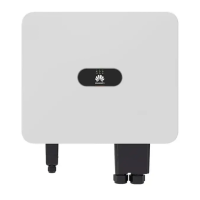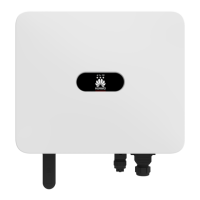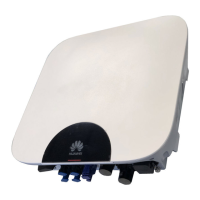● If no Low insulation resistance alarm is reported 1 minute after the DC side
is powered on, choose Maintenance > Inverter ON/OFF on the home screen,
and send a shutdown command. Set DC SWITCH to OFF. Go to Step 2 and
check rest of the PV strings one by one.
● If a Low insulation resistance alarm is reported 1 minute after the DC side is
powered on, check the percentage of possible short-circuit positions on the
Alarm details screen and calculate the location of the possible faulty PV
module based on the percentage. Then go to Step 4.
Step 4 Log in to the app, choose Maintenance > Inverter ON/OFF on the home screen,
and send a shutdown command. Set DC SWITCH to OFF. Check whether the
connectors or DC power cables between the optimizer and PV module, between
adjacent PV modules, or between adjacent optimizers on the possible fault
position are damaged.
● If yes, replace the damaged connectors or DC power cables, and then set DC
SWITCH to ON. If the inverter status is Shutdown: Command, choose
Maintenance > Inverter ON/OFF, and send a startup command. View alarm
information.
– If no Low insulation resistance alarm is reported 1 minute after the DC
side is powered on, troubleshoot the insulation resistance fault of the PV
string. Log in to the app, choose Maintenance > Inverter ON/OFF on the
home screen, and send a shutdown command. Set DC SWITCH to OFF.
Go to Step 2 and check rest of the PV strings one by one. Then, go to
Step 8.
– If the DC side is powered on 1 minute later, the Low insulation
resistance alarm is still reported. Log in to the app, choose Maintenance
> Inverter ON/OFF on the home screen, and send a shutdown command.
Set DC SWITCH to OFF and go to Step 5.
● If no, go to Step 5.
Step 5 Disconnect the possible faulty PV module and the paired optimizer from the PV
string, and use a DC extension cable with an MC4 connector to connect the PV
module or optimizer adjacent to the possible faulty PV module. Set DC SWITCH to
ON. If the inverter status is Shutdown: Command, choose Maintenance >
Inverter ON/OFF on the home screen, and send a startup command. View alarm
information.
● If no Low insulation resistance alarm is reported 1 minute after the DC side
is powered on, the fault occurred on the disconnected PV module and
optimizer. Choose Maintenance > Inverter ON/OFF, send a shutdown
command, and set DC SWITCH to OFF. Go to Step 7.
● If the Low insulation resistance alarm is reported 1 minute after the DC side
is powered on, the fault did not occur on the disconnected PV module and
optimizer. Go to Step 6.
Step 6 Log in to the app, choose Maintenance > Inverter ON/OFF on the home screen,
and send a shutdown command. Set DC SWITCH to OFF, reconnect the
disconnected PV module and optimizer, and repeat Step 5 to check the PV
modules and optimizers adjacent to the possible fault location.
Step 7 Determine the position of the ground insulation fault:
● Disconnect the possible faulty PV module from the optimizer.
SUN2000-(12KTL-25KTL)-M5 Series
User Manual D Locating Insulation Resistance Faults
Issue 03 (2023-02-15) Copyright © Huawei Digital Power Technologies Co., Ltd. 102

